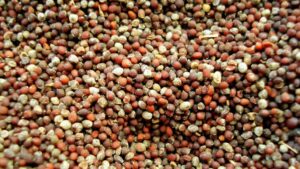Mustard, a condiment enjoyed by many, has an interesting journey from the field to the refrigerator. In Canada, the mustard industry plays a significant role in producing various mustard varieties that cater to different uses, tastes and preferences. On this week’s Seed Speaks, we dove into the world of Canadian mustard, highlighting the story of a mustard business revival, exploring the production process, discussing popular mustard varieties, addressing the impact of weather on the industry, and unveiling unique uses of mustard beyond condiments.
Joining us were Jeremy Kessler, owner of Ontario’s Kozlik’s Canadian Mustard, which creates over 30 kinds of specialty mustard and other products. Rick Mitzel, executive director of Sask Mustard, spoke about the importance of Saskatchewan’s mustard sector and the role new varieties are playing in the global importance of this crop. Kessler and Mitzel covered some major points, including:
Jeremy Kessler Resurrected a Mustard Business
In downtown Toronto, a chance encounter Kessler had with an older gentleman named Anton Kozlik led to Kessler taking over the business and helping build Kozlik’s into what it is today. Anton, who was closing down his mustard business due to illness, passed on his knowledge to Kessler. Kozlik’s Canadian Mustard was resurrected and continues to thrive. Established in 1948, the company produces hand-made mustard in small batches. Kozlik’s is proud to be a part of Canada’s mustard-making tradition, crafting its mustards with 100% Canadian mustard seed and sourcing its ingredients from local suppliers.
It All Begins With Growers
The journey of mustard begins with the growers: mustard seeds are cultivated in regions such as Saskatchewan, known for its favourable environment for mustard production. Grain merchants purchase the mustard directly from growers, ensuring the quality meets the standards desired by processors. The mustard seeds are then cleaned and processed by processors, who transform them into the various mustard varieties found on store shelves. Sask Mustard, with Mitzel at the helm, helps grow the Saskatchewan mustard industry for the benefit of producers. Sask Mustard funds research, communications and market development programs which are intended to improve yields, decrease input costs, increased demand and create an overall better product.
Good Mustard is Hot and Spicy
Canadian mustard offers a diverse range of flavours and varieties beyond the standard yellow condiment. Kessler emphasizes the importance of mustard having heat and spiciness, distinguishing it from the milder yellow mass-produced mustards. Some popular varieties include garlic, fruit and maple, along with classic Dijon mustard. Each variety aims to provide a unique and memorable taste experience.
Dry Weather Caused a 2022 Mustard Shortage
The mustard industry, like many agricultural sectors, faces challenges due to weather and climate changes, Mitzel notes. Drought conditions in Canada, particularly in 2021, led to a shortage of mustard seeds and subsequent price hikes. This shortage caused concerns in France, a major consumer of mustard seeds, leading to discussions about reducing dependence on Canadian imports. To mitigate the impact of weather, mustard growers have adopted practices such as minimum tillage and variable-rate seeding, while ongoing research focuses on developing drought-tolerant varieties.
Mustard Can Control Pests and Disease
Apart from being a popular condiment, mustard has other intriguing applications. Biofumigation, a technique to control soil-borne pests and diseases, has gained attention in the mustard industry, Mitzel notes. Certain mustard varieties rich in glucosinolates are grown and worked into the soil, providing natural control measures.
For more fascinating insights into Canadian mustard, watch the recorded version of this week’s episode above!












